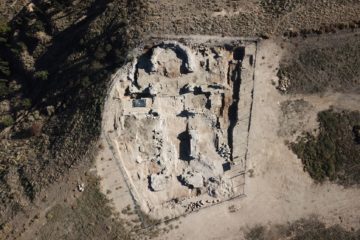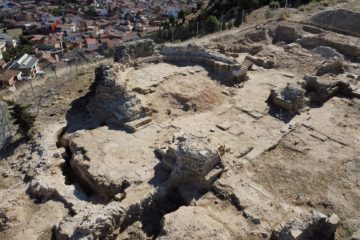Site: Female hospital monastery of Santa Maria d’Alguaire (el Segrià).
Campaigns: 2016 to present.
Directors: Maria Soler, Walter Alegría, Marta Sancho.
Coordinates: 298716, 4623491 (UTM31N – ETRS89)
Location and initial situation:
The site is located in the province of Lleida, in the municipality of Alguaire, on the crag known as Serra del Convent, with a privileged position that dominates the plain of Segrià. Spite of the vast extension of the site (4.6 ha), the visible remains before the excavation began were very scarce. Bordering the site on the southeastern and northeastern limits, there is a long wall of ramparts on stone courses that some authors interpret as part of an ancient fortress of Andalusian origin, for others it constitutes the perimeter wall of protection of the monastic enclosure. On the north-west boundary of the crag, we can see the remains of a stone structure that now we know was part of the apse of the conventual church.
Brief history:
With an Andalusian origin, the place of Alguaire appears in the county documentation in the middle of the 12th century, with the conquest and subsequent cession of a fortress to the Order of St. John of Jerusalem located in this sector with the purpose of founding a hospital commandery. The female monastery of Alguaire is heir to the one founded shortly before in Cervera, moved in the middle of the 13th century to the Sierra del Convent. It was a female monastery of hospitaller women, made up of the daughters of the highest Catalan nobility, headed by a prioress. We know that the domains of this order increased during the late Middle Ages, with possessions not only in the municipality of Alguaire but also in other parts of the Segrià plain.
The trajectory of the monastery experienced multiple vicissitudes. We know that the monastery suffered the irruption of the Catalan Civil War of the 15th century, but much more intense was the onslaught of the Reapers’ War, that in 1640 forced the community to take refuge in the episcopal palace of Lleida. Its location in war front territory and the economic difficulties to continue subsisting determined that in 1644 the community moved to Barcelona. In 1651, a plague affected the city of Barcelona and the nuns, after eleven years of absence, returned to Alguaire.
Return to the monastery was not easy because the building was in ruin and repairs were necessary. The economic difficulties and the poor state of the monastery pushed the community to request, in 1684, the definitive transfer to Barcelona. In spite of the initial opposition of the bishopric of Lleida, their departure was authorized and the nuns left Alguaire definitively in 1699, moving to the palace of the Grand Prior of Catalonia. In this location they continued, not without some interruptions, until 1880, when they were transferred to Sant Gervasi de Cassoles and, later, in 1976, they settled in the new monastery built in Valldoreix, which was left uninhabited in 2007 due to lack of vocations.
Archaeological interventions:
The archaeological excavations began in 2016 through a collaboration agreement between the City Council of Alguaire and the University of Barcelona, with the purpose of studying the site historical-archaeological trajectory. At 2018, these works were integrated within the project “Castles, Monasteries and Palaces. Power, Territory and Landscape (XII-XVII centuries)” funded by the archaeological research program of the Generalitat de Catalunya and the City Council of Alguaire.
The excavations carried out to date have allowed us to document the structures corresponding to the monastery church. The remains located show the existence of a monumental church of large dimensions (5.5 m wide x 30 m long). The nave of the temple was covered with a vault supported by four pairs of pillars decorated with half-round columns. The church had a transept and a raised apse, as well as several side chapels. Although the community accessed the church through the door leading to the cloister, the main doorway was located at the foot of the nave and had a monumental character.
BIBLIOGRAPHY
ALTURO I PERUCHO, Jesús: Diplomatari d’Alguaire i el seu monestir duple de l’ordre de Sant Joan de Jerusalem (1245-1300). Barcelona, Fundació Noguera, 2010.
BERTRAN I ROIGÉ, Prim: “Les ordinacions del convent d’Alguaire”, Cuadernos de Historia económica de Cataluña, 17 (1977), p. 25-56.
COLL SANABRA, Araceli: Diplomatari del Monestir Santjoanista d’Alguaire (1301-1350): estudi i edició. Tesi doctoral inèdita, Universidad Autònoma de Barcelona, 2016.
FUGUET SANS, Joan: Templers i Hospitalers. Guia de les terres de Ponent i la Franja. Barcelona, Rafael Dalmau, 2000.
LLADONOSA, Josep: Història de la Vila d’Alguaire i el seu Monestir Santjoanista. Lleida. Gràfiques Larrosa, 2007.
SANS I TRAVÉ, J.M.: “Els ordes militars a Catalunya”, Catalan Historical Review, 4 (2011), p. 201-225.
SOLER SALA, Maria: “Arqueología de los espacios monásticos medievales: el monasterio femenino de Alguaire (El Segrià)”, VI Congreso de Arqueología Medieval (España-Portugal). Alicante, SEAM, 2019, p. 607-613.










